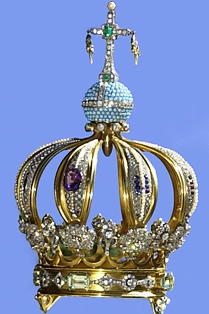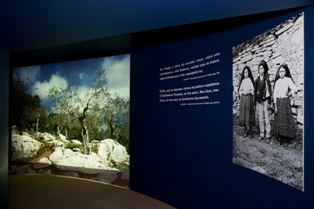03 august, 2012
 The Museum of the Shrine of Fatima celebrates, in August 2012, two very important dates for the spread of the Message of Fatimaand for reflection on the material testimonies that, inherited from the past and related to the manifestation of faith by pilgrims, keep on extending their usefulness through the speech of museology. The twopermanent exhibitions of the Museum were inaugurated in the month of August andhave, throughout these years, revealed themselves to be special spaces –each one in its own way – for the contemplation of the Message of Fatima.
On August 5 there occur ten years since theinauguration of the permanent exhibition ‘Fatima Light and Peace’,installed at the RectoryBuilding, in whichpilgrims can contemplate a significant number of material testimonies of theumbilical relationship they have with the Mother of God.
Next August 19 the House-Museum of Aljustrelcompletes twenty years of mission, serving the pilgrims visiting the historicalvillage where the Little Shepherds were born.
Secção de Arte e Património The Museum of the Shrine of Fatima celebrates, in August 2012, two very important dates for the spread of the Message of Fatimaand for reflection on the material testimonies that, inherited from the past and related to the manifestation of faith by pilgrims, keep on extending their usefulness through the speech of museology. The twopermanent exhibitions of the Museum were inaugurated in the month of August andhave, throughout these years, revealed themselves to be special spaces –each one in its own way – for the contemplation of the Message of Fatima.
On August 5 there occur ten years since theinauguration of the permanent exhibition ‘Fatima Light and Peace’,installed at the RectoryBuilding, in whichpilgrims can contemplate a significant number of material testimonies of theumbilical relationship they have with the Mother of God.
Next August 19 the House-Museum of Aljustrelcompletes twenty years of mission, serving the pilgrims visiting the historicalvillage where the Little Shepherds were born.
Secção de Arte e Património
Fatima Light and Peace Last August 5 marked ten years since the inauguration of the exhibition Fatima Light and Peace, where part of the treasures of the Shrine’s Museum is permanently exposed. The museological course, conceived by Maria Teresa Gomes Ferreira, and the museography, planned by Cruz Carvalho, have in view to place the visitor in the presence of the core of the Message of Fatima and to question him, right at the start, through the motto: “from war to peace”, “from darkness to light”. After that initial tangible scenario, which places the visitor before the historical scenario of World War I, the message showing the gratitude of pilgrims towards the Mother of God, venerated here under the title of Our Lady of the Rosary of Fatima, is transmitted by means of a film.  Amongst the objects exhibited there stand out: from the Jewelry Collection, the precious crown of Our Lady of Fatima, where the bullet which hit Blessed John Paul II is enchased; liturgical paraphernalia, such as monstrances, chalices, pyxes. The exhibition’s oldest item, an Indo-Portuguese Christ, of the XVII century, is found in the Sculpture Collection. From the Textile Collection there are exposed different vestments connected with pilgrimages of Popes to the Shrine of Fatima, as well as some items of regional dress or connected with religious rituals, such as Baptismal dresses and bride’s gowns; also some identifying social or professional status, such as student and military uniforms, the mantel of a queen and the clothes of a bullfighter.
The Jewelry Collection mirrors best the devotion to Our Lady. Consisting of items of personal decoration, most made of gold, it is, within the universe of museum collections of this kind, the most significant collection of this type, which allows for the most varied studies (artistic, ethnographic, anthropologic) aiming to understand the filial relation of pilgrims towards the Virgin Mary.
Many other objects are found there, such as the traditional “ex-votos”, namely, photos, wax figures, candles, boat miniatures, etc.
This space has seen more than 681,240 visitors go through it, an average of 5,773 per month. Since it was opened, the visitors are welcomed by the Sisters belonging to the Congregation of the Oblate Sisters of Mary Virgin of Fatima and those belonging to Casa de Maria (House of Mary).
Marco Daniel Duarte
Amongst the objects exhibited there stand out: from the Jewelry Collection, the precious crown of Our Lady of Fatima, where the bullet which hit Blessed John Paul II is enchased; liturgical paraphernalia, such as monstrances, chalices, pyxes. The exhibition’s oldest item, an Indo-Portuguese Christ, of the XVII century, is found in the Sculpture Collection. From the Textile Collection there are exposed different vestments connected with pilgrimages of Popes to the Shrine of Fatima, as well as some items of regional dress or connected with religious rituals, such as Baptismal dresses and bride’s gowns; also some identifying social or professional status, such as student and military uniforms, the mantel of a queen and the clothes of a bullfighter.
The Jewelry Collection mirrors best the devotion to Our Lady. Consisting of items of personal decoration, most made of gold, it is, within the universe of museum collections of this kind, the most significant collection of this type, which allows for the most varied studies (artistic, ethnographic, anthropologic) aiming to understand the filial relation of pilgrims towards the Virgin Mary.
Many other objects are found there, such as the traditional “ex-votos”, namely, photos, wax figures, candles, boat miniatures, etc.
This space has seen more than 681,240 visitors go through it, an average of 5,773 per month. Since it was opened, the visitors are welcomed by the Sisters belonging to the Congregation of the Oblate Sisters of Mary Virgin of Fatima and those belonging to Casa de Maria (House of Mary).
Marco Daniel DuarteMuseum of the Shrine of Fatima |